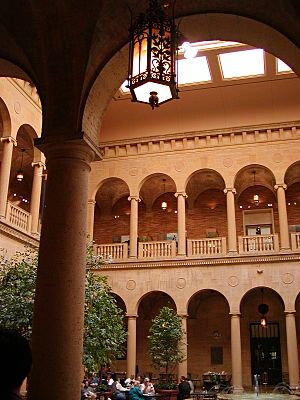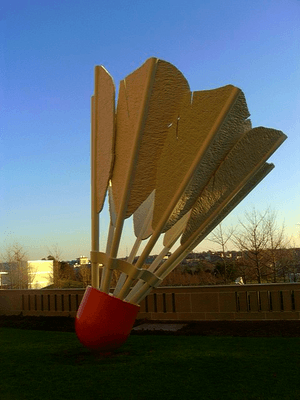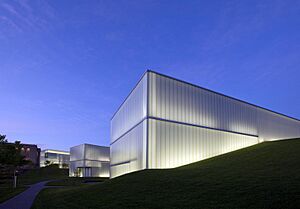Nelson-Atkins Museum of Art facts for kids
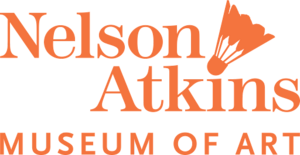 |
|

North façade of the original museum building (right), with Bloch Building (left).
|
|
| Former name | William Rockhill Nelson Gallery of Art |
|---|---|
| Established | 1933 |
| Location | 4525 Oak St Kansas City, Missouri |
| Type | Art museum |
| Collection size | 40,000 works |
| Visitors | 508,000 (2022-23) |
The Nelson-Atkins Museum of Art is a famous art museum located in Kansas City, Missouri. It's known for its huge collection of art from almost every continent and culture around the world. The museum is especially famous for its amazing collection of Asian art.
In 2007, Time magazine called the museum's new Bloch Building one of the "10 Best Architectural Marvels" in the world. This shows how special its design is!
The museum is open five days a week: Monday, Thursday, and Friday from 10 am to 9 pm, and Saturday and Sunday from 10 am to 5 pm. It is closed on Tuesdays and Wednesdays. The best part? Admission is completely free!
Contents
Discovering the Museum's History
The museum was built on the land where Kansas City Star newspaper owner William Rockhill Nelson lived. When he passed away in 1915, his will said that his money should be used to buy art for everyone to enjoy. Other family members also added funds to this special gift.
Around the same time, a woman named Mary McAfee Atkins also left money to start an art museum. Her gift grew quite a bit over the years. Instead of building two separate museums, the people in charge decided to combine the money. This allowed them to create one big, impressive art institution.
The museum building was designed by famous Kansas City architects, Wight and Wight. Construction began in 1930, and the museum officially opened its doors on December 11, 1933. The building's classic style was inspired by the Cleveland Museum of Art.
When it first opened, the museum was sometimes called the Nelson Art Gallery. It wasn't until 1983 that it was officially named the Nelson-Atkins Museum of Art.
Because William Nelson donated money instead of his own art collection, the museum's curators could buy art from scratch. This was during the Great Depression, when many artworks were for sale at good prices. This allowed the museum to quickly build one of the largest art collections in the country.
Meet the Museum Directors
The museum has had several leaders who helped it grow and become what it is today.
Paul Gardner: The First Director (1933–1953)
Paul Gardner was the museum's very first director. He studied architecture and art history. He started as an assistant in 1932 and became director a year later. He led the museum for twenty years.
Laurence Sickman: Asian Art Expert (1953–1977)
Laurence Sickman became the second director. He had a deep interest in Japanese and Chinese art from a young age. He even lived in China to study and buy art for the museum. Thanks to his efforts, the Nelson-Atkins gained one of the best Asian art collections in the United States.
One of his biggest achievements was bringing a major exhibition called "Archaeological Finds of the People's Republic of China" to Kansas City in 1975. It attracted nearly 300,000 visitors!
Ted Coe: Native American Art Advocate (1977–1982)
Ralph Tracy "Ted" Coe was the third director. Before becoming director, he organized several popular exhibitions. His most famous was "Sacred Circles," which featured 900 Native American art objects. This show was a huge success and drew over 245,000 visitors to the museum.
Marc Wilson (1982–2010)
Marc Wilson served as director for many years, from 1982 to 2010.
Julián Zugazagoitia: Current Director (2010–Present)
Julián Zugazagoitia became the museum's fifth director on September 1, 2010. He continues to lead the museum today.
The Modern Bloch Building Addition
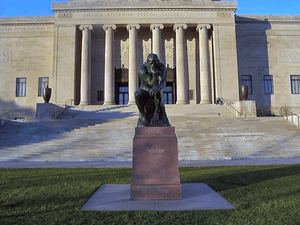
In the 1990s, the museum decided it needed more space. Architect Steven Holl won a competition in 1999 to design a new addition. His idea was to build five glass structures, which he called "lenses," to the east of the original building. These lenses sit on top of a large underground area known as the Bloch Building.
The Bloch Building is named after H&R Block co-founder Henry W. Bloch. It holds the museum's modern art, African art, photography, and special exhibits. It also has a new cafe and the museum's library. This addition cost about $95 million and opened on June 9, 2007.
Many people loved the new design. New York Times art critic Nicolai Ouroussoff praised it, saying it showed how art and architecture can work together beautifully. The museum even uses natural light from the glass lenses to light some of its artworks, thanks to new glass technology that protects the art.
Admission to the museum is free every day. You can enter through any of its seven entrances, with the main visitor's desk now in the Bloch Building. Outside, a reflecting pool with 34 round openings lets natural light into the underground parking garage. The famous The Thinker sculpture, which used to be at the north entrance, was moved to the south side of the museum.
Amazing Art Collections
The Nelson-Atkins Museum has a wide variety of art from different times and places.
Ancient Wonders
This collection features art from ancient civilizations like Egypt, Greece, Rome, and the Near East. You can see portraits of pharaohs and queens, jewelry from ancient cities, and sculptures from old palaces. The Greek collection includes statues and pottery of gods and heroes. Roman art features statues of emperors and early Christian works.
During the COVID-19 pandemic, the museum offered a virtual tour of its Queen Nefertari exhibit. This exhibit showcased 230 pieces of art about Queen Nefertari and other important women of ancient Egypt.
European Masterpieces
The museum has a highly valued collection of European paintings. You can see works by famous artists like Caravaggio, El Greco, Rembrandt, Titian, Vincent van Gogh, and Claude Monet.
One exciting discovery happened in 2016. A small painting called The Temptation of St. Anthony, once thought to be from the workshop of Hieronymus Bosch, was confirmed to be painted by Bosch himself! This is a big deal because there are only about 25 known Bosch paintings in the world.
The museum also works to research art pieces that were taken during the Nazi era. They try to find the original owners or their families to return the art or keep it on display with their permission.
Asian Treasures
The museum is very famous for its huge collection of Asian art, especially from Imperial China. It also has pieces from Japan, India, Korea, and other parts of Asia. Much of this collection was bought in the early 20th century by Laurence Sickman, who was an expert in Chinese art.
You can see beautiful Chinese antique furniture, including special glazed pottery figures called luohans. The Japanese collection includes screen paintings, scrolls, and about 500 woodblock prints by artists like Katsushika Hokusai.
African Art
Most of the African artworks come from West and Central Africa, including countries like Mali, Ivory Coast, and Nigeria. The museum started collecting African art in the 1930s.
In 2012, the African art gallery added videos and photos to show visitors how these objects are used in real life. The collection has about 400 objects made from wood, brass, beads, and other materials. You can see royal stools, masks, and shrine figures from different African cultures.
The museum also hosted an exhibit called 'Through African Eyes' which explored how African artists viewed Europeans over many centuries.
Native American Art
In 2009, the museum opened large galleries dedicated to Native American art. These galleries display about 200 pieces, from thousands of years old to modern works by Native American artists.
The collection includes pottery, baskets, beadwork, and paintings from many different tribes like the Arikara, Lakota, and Navajo. The Nelson-Atkins works with Native American communities to ensure art is displayed respectfully or returned if it belongs to a specific cultural site. The museum also hosts cultural performances, sharing Indigenous singing, dancing, and storytelling.
American Art
The American gallery features art by American artists who are not Native American. It has the largest public collection of works by Thomas Hart Benton, who lived in Kansas City. You can also find paintings by George Bellows, Winslow Homer, and John Singer Sargent.
A notable exhibit called "30 Americans" showed African American life through the eyes of 30 different artists. In 2023, the museum won a painting called "Sailing" by Thomas Eakins from a friendly bet with the Philadelphia Museum of Art after the Kansas City Chiefs won the Super Bowl!
Modern Art
This collection covers art made from the 1860s to the 1970s. It includes styles like Cubism, Expressionism, Surrealism, and Abstract Expressionism. You can see works by famous artists such as Pablo Picasso, Jackson Pollock, Paul Klee, and Henry Moore.
Photography Collection
The Photography galleries in the Bloch Building show the history of photography, from early daguerreotypes to modern digital images. New exhibits are presented several times a year. The museum also has one of the oldest known photos of enslaved people in the US, taken in 1850.
In 2006, Hallmark Cards chairman Donald J. Hall, Sr. donated the entire Hallmark Photographic Collection to the museum. This huge collection covers the history of photography from 1839 to today, with a focus on American photographers.
Contemporary Art
Contemporary art, made from 1960 to the present day, is also located in the Bloch Building. This collection includes styles like Pop, Minimalism, and Realism from artists around the world. You can see works by Andy Warhol, Anish Kapoor, Robert Rauschenberg, and Kerry James Marshall.
The Noguchi Sculpture Court, at the south end of the Bloch Building, houses modern sculptures. It has one of the largest collections of Isamu Noguchi's work outside of New York and Japan.
Design and Decorative Arts
This collection includes everything from medieval stained glass to modern furniture made by Kansas City artists. Important pieces include a 16th-century armor set for a knight and his horse, and a large collection of English pottery. These items help show how art was used in everyday life throughout history.
Donald J. Hall Sculpture Park
Outside the museum, on its large lawn, is the Donald J. Hall Sculpture Park. This park has the biggest collection of large bronze sculptures by Henry Moore in the United States. You can also find works by other artists like Alexander Calder and Auguste Rodin.
The park is especially famous for Shuttlecocks, a four-part outdoor sculpture of giant badminton shuttlecocks. These fun sculptures stand 18 feet tall and were created by Claes Oldenburg and Coosje van Bruggen.
Learning About Art's Journey
The Nelson-Atkins Museum of Art carefully researches the history of ownership for all its artworks. This is called provenance research. It helps the museum understand where each piece came from and ensures that all acquisitions were made properly.
One special exhibit, Origins: Collecting to Create the Nelson-Atkins, explored how the museum built its amazing collection over the years.
See also
 In Spanish: Museo de Arte Nelson-Atkins para niños
In Spanish: Museo de Arte Nelson-Atkins para niños


